Several Wetherspoon pubs have ‘moon’ in their name, linking them with the ideal pub described by George Orwell. The famous author called his fictitious pub ‘Moon Under Water’. This pub occupies a three-storey building which was a long-time grocer’s, then an annexe of Allders department store. It was built in the 1930s on the site of Sutton’s first hospital – which opened in 1902 and was paid for by John Passsmore Edwards.
A framed text about the history of Sutton, also including an image of Sir Nicholas Carew – First Lord of the Manor of Sutton.
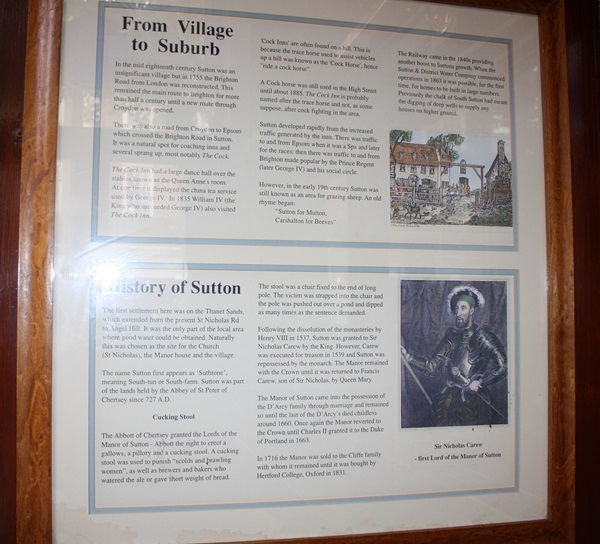
The text reads: From Village to Suburb
In the mid eighteenth century Sutton was an insignificant village but in 1755 the Brighton Road from London was reconstructed. This remained the main route to Brighton for more than half a century until a new route through Croydon was opened.
There was also a road from Croydon to Epson which crossed the Brighton Road Sutton. It was a natural spot for coaching inns and several sprang up. Most notably The Cock.
The Cock Inn had a large dance hall over the stables known as the Queen Anne’s room. At one time it displayed the china tea service used by George IV (the King who succeeded George IV) also visited The Cock In.
‘Cock Inns’ are often found on a hill. This is because the trace horse used to assist vehicles up a hill was known as the ‘Cock Horse’, hence ‘rides a cock horse’.
A Cock horse was still used in the High Street until about 1855. The Cock Inn is probably named after the trace and not, as some suppose, after cock fighting in the area.
Sutton developed rapidly from the increased traffic generated by the Inns.
There was traffic to and from Epsom when it was a spa and later for the races; then there was traffic to and from Brighton made popular by the Prince Regent (later George 1V) and his social circle.
However, in the early 19th century Sutton was still known as an area for grazing sheep. An old rhyme began:
“Sutton for Mutton,
Carshalton for Beeves”
The Railway came in the 1840’s providing another boost to Sutton’s growth. When the Sutton & District Water Company commenced operations in 1863 it was possible, for the first time, for homes to be built in large numbers. Previously the chalk of South Sutton had meant the digging of deep wells to supply any houses on higher control.
History of Sutton
The first settlement here was on the Thanet Sans, which extended form the present St Nicholas Rd to Angel Hill. It was the only part of the local area where good water could be obtained. Naturally this was chosen as the site for the Church (St Nicholas), the Manor house and the village.
The name Sutton first appears as ‘Suthtone’, meaning South-tun or South-farm. Sutton was part of the lands held by the Abbey of St Peter of Chertsey since 727 A.D.
Cucking Stool
The Abbott of Chertsey granted the Lords of the Manor of Sutton – Abbott the right to erect a gallows, a pillory and cucking stool. A cucking stool was used to punish “scolds and brawling women”, as well as brewers and bakers who watered the ale or gave short weight of bread.
The stool was a chair fixed to the end of long pole. The victim was strapped into the chair and the pole was pushed out over a pond and dipped as many times as the sentence demanded.
Following the dissolution of the monasteries by Henry VIII in 1537, Sutton was granted to Sir Nicholas Carew by the King. However, Carew was executed for treason in 1539 and Sutton was repossessed by the Monarch. The Manor remained with the crown until it was returned to Francis Carew, son of Sir Nicholas, by Queen Mary.
The Manor of Sutton came into the possession of the D’Arcy family through marriage and remained so until the last day of D’ Arcy’s died childless around 1660. Once again the Manor reverted to the Crown until Charles II granted it to the Duke of Portland in 1663.
In 1716 the Manor was sold to the Cliffe family with whom it remained until it was bought by Hertford College, Oxford in 1831.
Framed photographs and text about entertainment in the 1860–90s.
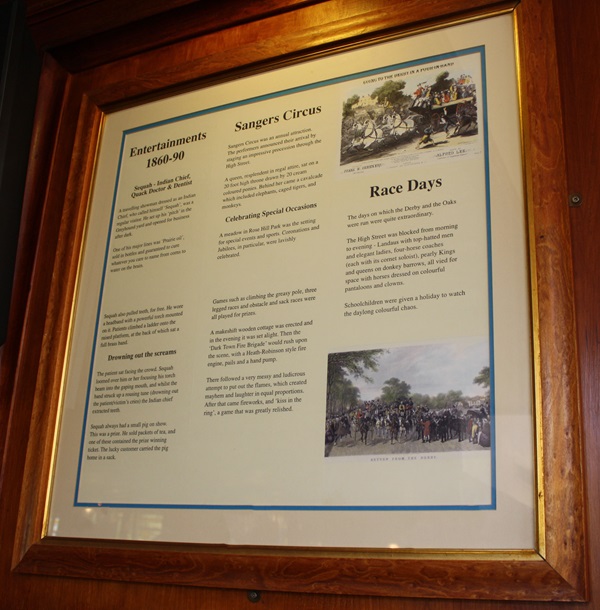
The text reads: Entertainments 1860-90
Sequah- Indian Chief, Quack Doctor & Dentist
A travelling showman dressed as an Indian Chief, who called himself ‘Sequah’, was a regular visitor. He set up his ‘pitch’ in the Greyhound yard and opened for business after dark.
One of his major lines was ‘Prairie oil’; sold in bottles and guaranteed to cure whatever you care to name from corns to water on the brain.
Sequah also pulled teeth, for free. He wore a headband with a powerful torch mounted on it. Patients climbed a ladder onto the raised platform, at the back of which sat a full brass band.
Drowning out the screams
The patient sat facing the crowd, Sequah loomed over him or her focusing his torch beam into the gaping mouth, and whilst the band struck up a rousing tune (drowning out the patient/victim’s cries) the Indian Chief extracted teeth.
Sequah always had a small pig on show. This was a prize. He sold packets of tea, and one of these contained the prize winning ticket. The Lucky Customer carried the pig home in a sack.
Sangers Circus
Sangers Circus was an annual attraction. The performers announced their arrival by staging an impressive procession through the High Street.
A queen, resplendent in regal attire, sat on a 20 foot high throne drawn by 2o cream coloured ponies. Behind her came a cavalcade which included elephants, caged tigers, and monkeys.
Celebrating Special Occasions
A meadow in Rose Hill Park was the settings for special events and sports. Coronations and Jubilees, in particular, were lavishly celebrated.
Games such as climbing the greasy pole, three legged races and obstacle and sack races were all played for prizes.
A makeshift wooden cottage was erected and in the evening it was set alight. Then the ‘Dark Town Fire Brigade’ would rush upon the scene, with a Health- Robinson style fire engine, pails and a hand pump.
There followed a very messy and ludicrous attempt to put out the flames, which created mayhem and laughter in equal proportions. After that came fireworks, and ‘kiss in the ring’, a game that was greatly relished.
Race Days
The days on which the Derby and the Oaks were run were quite extraordinary.
The High Street was blocked from morning to evening- Landaus with top-hatted men and elegant ladies, four-horse coaches (each with its cornet soloist), pearly Kings and queens on donkey barrows, all vied for space with horses dressed on colourful pantaloons and clowns.
School children were given a holiday to watch the daylong colourful chaos.
A framed photograph and text about Graham Sutherland (1903–1980).
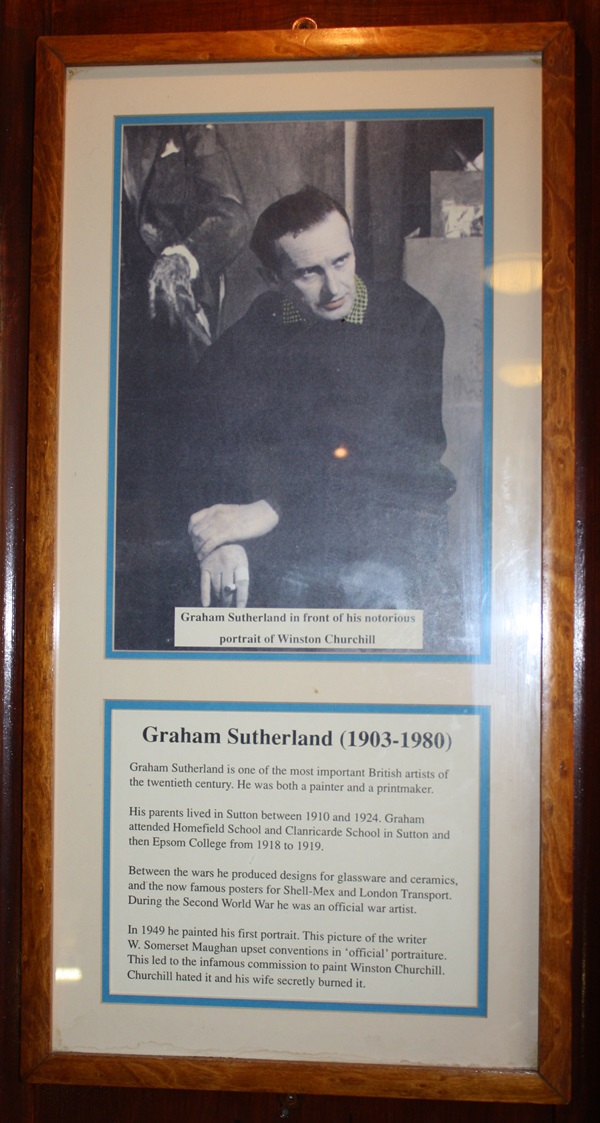
The text reads: Graham Sutherland is one of the most important British artists of the twentieth century. He was both a painter and a printmaker.
His parents lived in Sutton between 1910 and 1924. Graham attended Homefield School and Clanricarde School in Sutton and then Epsom College from 1918 – 1919.
Between the wars he produced designs for glassware and ceramics, and now famous posters for Shell- Mex and London Transport. During the second world war he was an official war artist.
In 1949 he painted his first portrait. This picture of the writer W. Somerset Maughan upset conventions in ‘official’ portraiture. This led to the infamous commission to paint Winston Churchill. Churchill hated it and his wife secretly burned it.
Top: Graham Sutherland in front of his notorious portrait of Winston Churchill
A framed photograph and text about modern transport in Sutton.
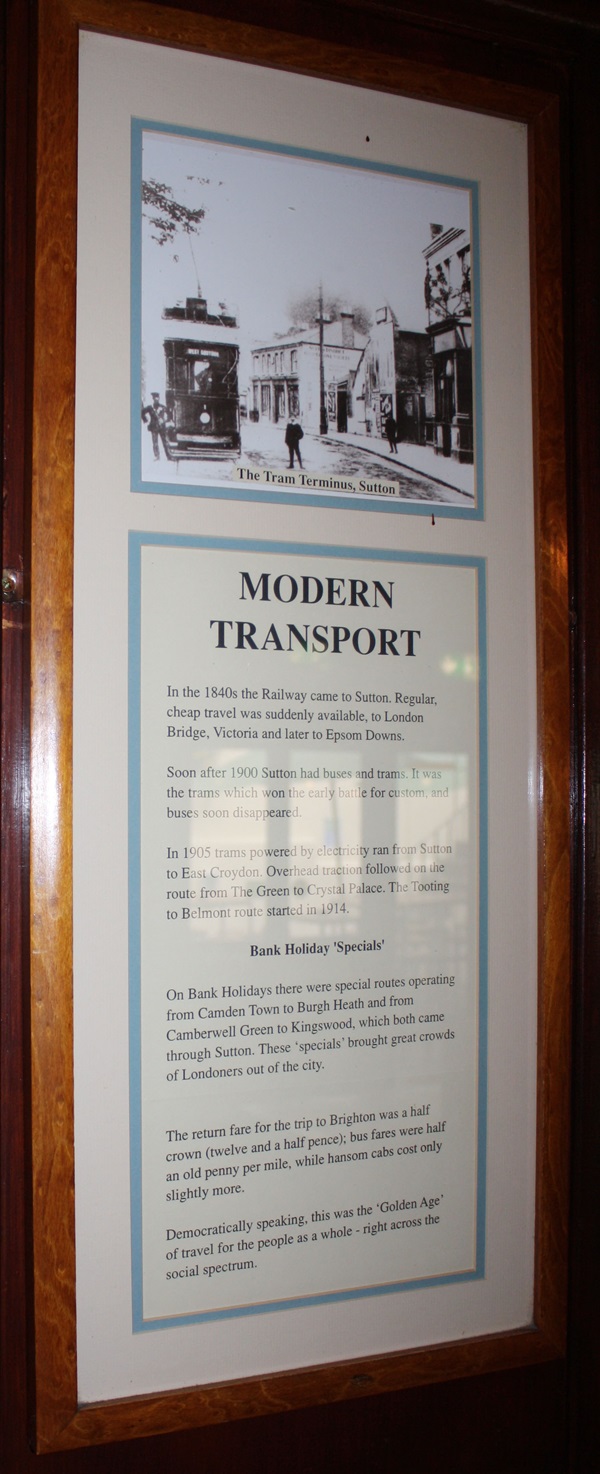
The text reads: In the 1840’s the Railway came to Sutton. Regular, cheap travel was suddenly available, to London Bridge, Victoria and later to Epsom Downs.
Soon after 1900 Sutton had buses and trams. It was the trams which won early battle for custom, and buses soon disappeared.
In 1905 trams powered by electricity ran from Sutton to East Croydon. Overhead traction followed on the route from The Green to Crystal Palace. The Tooting to Belmont route started in 1914.
On Bank Holidays there were special routes operating from Camden Town to Burgh Health and from Camberwell Green to Kingswood, which both came through Sutton. Theses ‘specials’ brought great crowds of Londoners out of the city.
The return for the trip to Brighton was a half crown (twelve and half pence); bus fares were half an old penny per mile, while hanson cabs cost only slightly more.
Democratically speaking, this was the ‘Golden Age’ of travel for the people as a whole- right across the social spectrum.
A framed photograph and text about HG Wells.
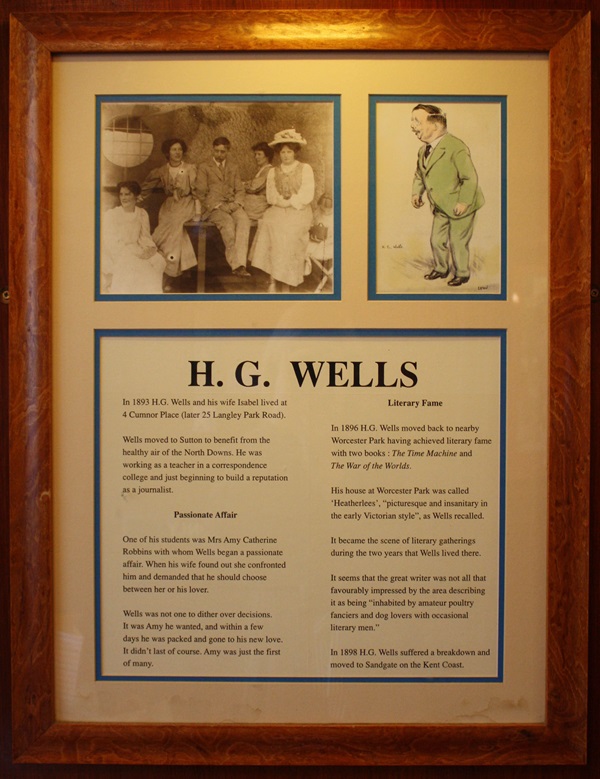
The text reads: In 1893 H.G. Wells and his wife Isabel lived at 4 Cumnor Place (later 25 Langley Park Road).
Wells moved to Sutton to benefit from the healthy air of the North Downs. He was working as a teacher in a correspondence college and just beginning to build a reputation as a journalist.
One off his students was Mrs Amy Catherine Robbins with whom Wells began a passionate affair. When his wife found out she confronted him and demanded that he should choose between her or his lover.
Wells not one to dither over decisions. It was Amy he wanted, and within a few days he was packed and gone to his new love. It didn’t last of course. Amy was just the first of many.
In 1896 H.G Wells moved back to nearby Worcester Park having achieved literary fame with two books: The Time Machine and The War of the Worlds.
His house at Worcester Park was called ‘Heatherless’, “Picturesque and insanitary in the early Victorian style”, as Wells recalled.
It became the scene of literary gatherings during two years that Wells lived there.
It seems that the great writer was not all that favourably impressed by the area describing it as being “inhabited by amateur poultry fanciers and dog lovers with occasional literary men”
In 1898 H.G Wells suffered a breakdown and moved to Sandgate on the Kent Coast.
Framed photographs of High Street, Sutton, c1900.
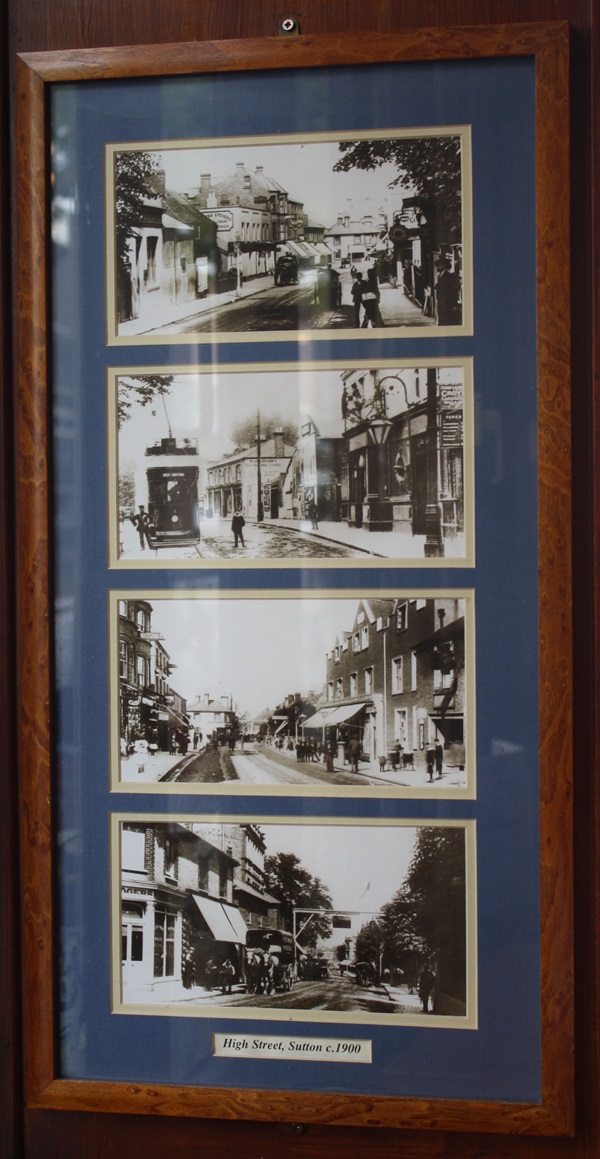
A framed photograph of High Street, Sutton, c1916.
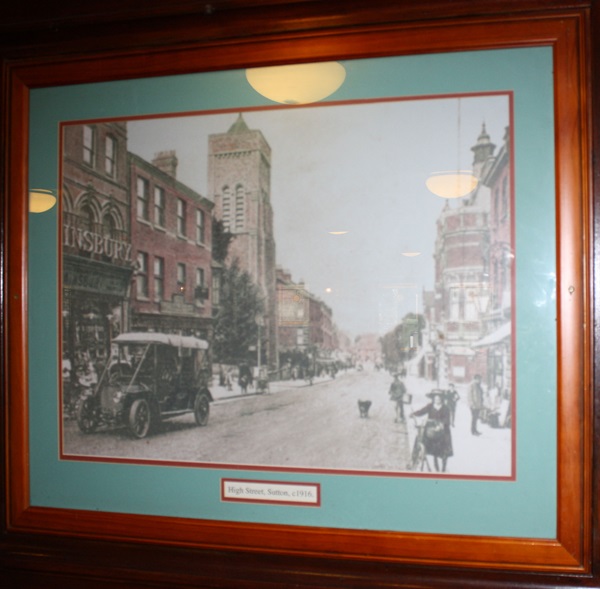
A framed photograph of High Street from the railway station.
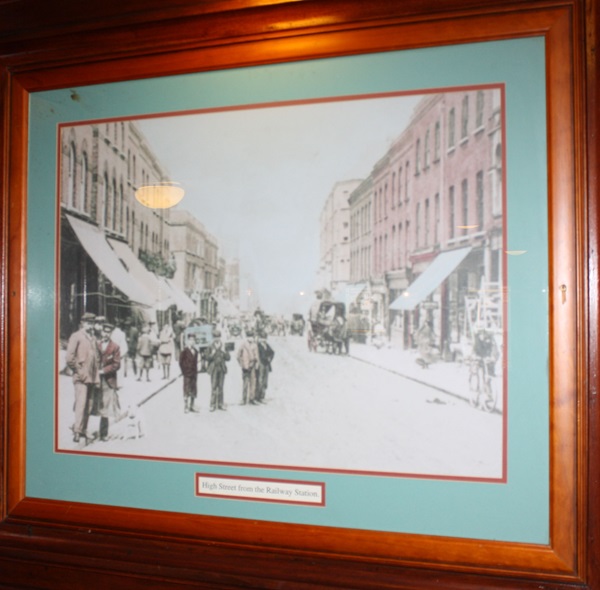
A framed photograph of ‘Sutton’ – the first motor train, 1906.

A framed photograph of The Arcade, Sutton.
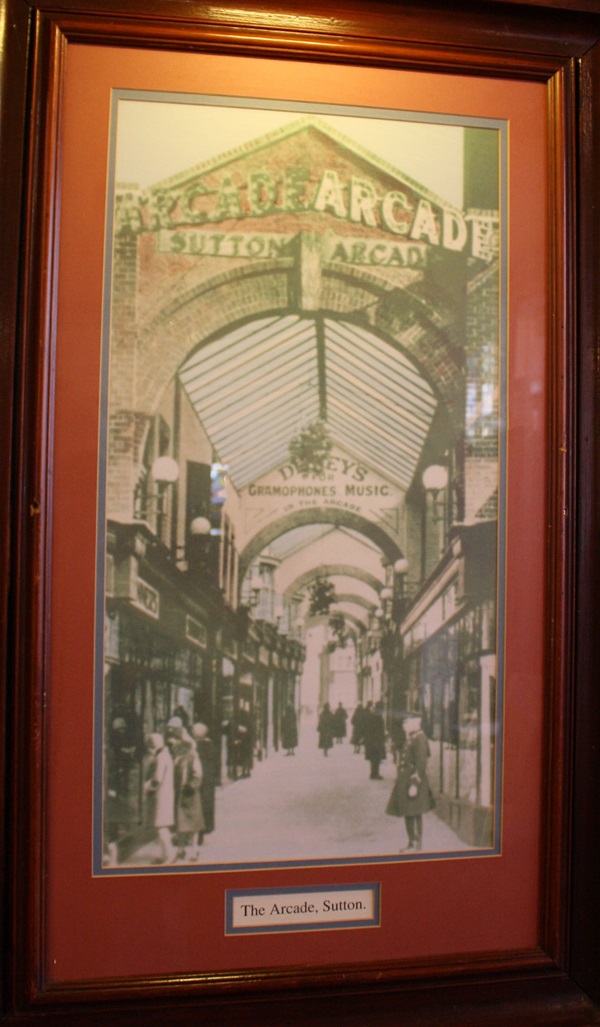
A metal sculpture of a tree. These can be found throughout the pub.
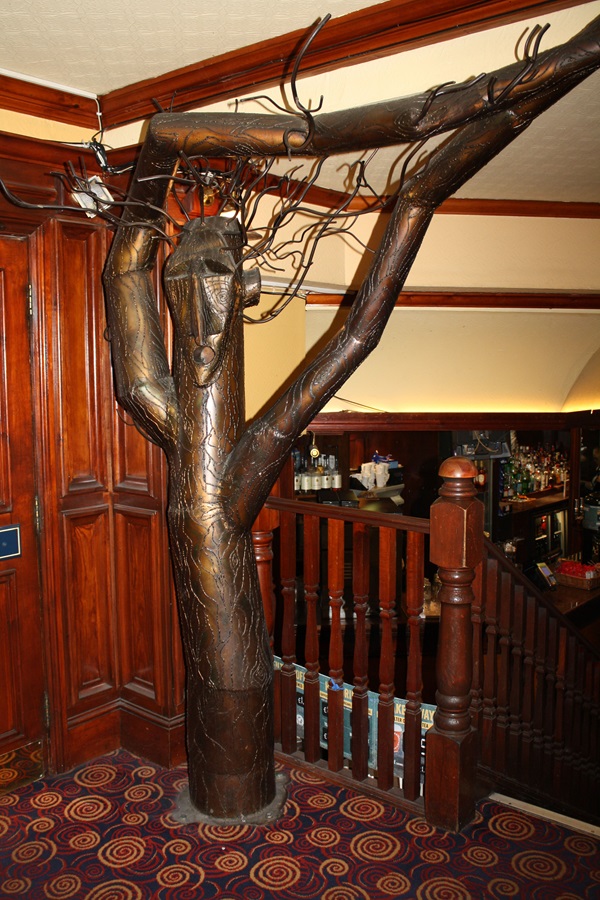
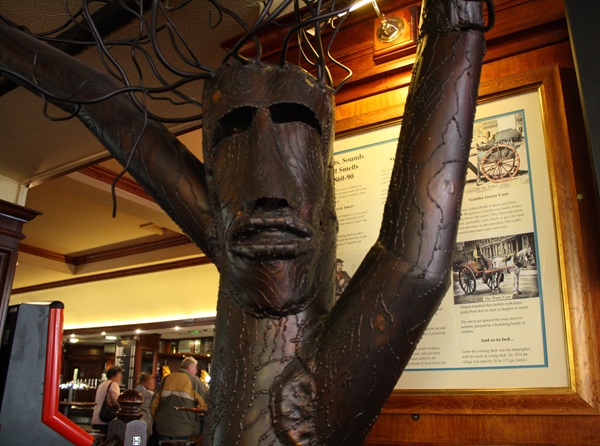
External photograph of the building – main entrance.
.jpg?h=400&&w=600&la=en&hash=E797913CFB0EB4EC5C5A69E1BE66646983D401C6)
If you have information on the history of this pub, then we’d like you to share it with us. Please e-mail all information to: pubhistories@jdwetherspoon.co.uk